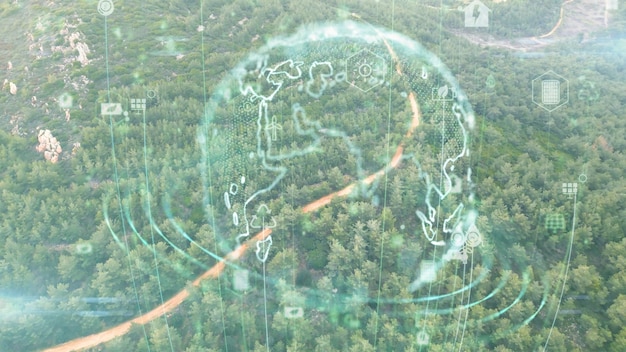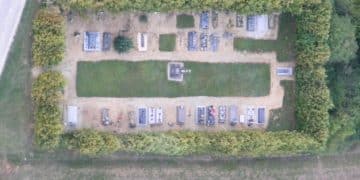Geoengineering in the US: Benefits and Risks of Climate Change Mitigation

Geoengineering technologies offer potential benefits for mitigating climate change in the US, such as reducing global temperatures and alleviating extreme weather events, but also present significant risks, including unintended regional climate shifts and ecological disruptions.
The increasing urgency of climate change has spurred interest in geoengineering technologies as potential tools for mitigating its effects in the US. But what are the potential benefits and risks of geoengineering technologies for mitigating climate change in the US? This article explores both sides, providing a balanced perspective.
Understanding Geoengineering: An Overview
Geoengineering, also known as climate engineering, encompasses a range of technologies aimed at deliberately altering the Earth’s climate system. These technologies are broadly categorized into two main types: solar radiation management (SRM) and carbon dioxide removal (CDR). Understanding these approaches is crucial for assessing their viability and impact in the US.
Solar Radiation Management (SRM)
SRM techniques focus on reflecting a small percentage of incoming sunlight back into space, thereby reducing the amount of solar energy absorbed by the Earth. This approach seeks to lower global temperatures quickly, mimicking the effects of volcanic eruptions. However, it does not address the root cause of climate change, which is the accumulation of greenhouse gases.
Carbon Dioxide Removal (CDR)
CDR technologies aim to remove carbon dioxide directly from the atmosphere. This approach addresses the primary driver of climate change by reducing the concentration of greenhouse gases. CDR methods are generally considered more sustainable but are often slower to implement and may require significant land or energy resources.

Both SRM and CDR have distinct characteristics and implications for the US, making it essential to evaluate their potential benefits and risks comprehensively. Geoengineering stands as a pivotal, albeit contentious, strategy in the climate action playbook.
Potential Benefits of Geoengineering in the US
Geoengineering technologies offer several potential benefits for the US in terms of mitigating the impacts of climate change. From reducing extreme weather events to safeguarding critical infrastructure, these technologies could play a significant role in protecting American communities and ecosystems.
Mitigating Extreme Weather Events
One of the most compelling potential benefits of geoengineering is its ability to reduce the intensity and frequency of extreme weather events. SRM techniques, in particular, could lower surface temperatures, potentially mitigating the severity of heatwaves, droughts, and intense storms. This could translate to reduced economic losses and improved public safety across the US.
Protecting Critical Infrastructure
Climate change poses a significant threat to critical infrastructure in the US, including transportation networks, energy grids, and water management systems. Geoengineering could help protect these assets by reducing the rate of sea-level rise and minimizing the impact of extreme weather. This would ensure the continued functioning of essential services and support economic stability.
- Reduced Wildfires: Lowering temperatures could decrease the risk of wildfires, particularly in the western US.
- Coastal Protection: Slowing sea-level rise could safeguard coastal communities and infrastructure.
- Agricultural Benefits: Stabilizing weather patterns could improve agricultural yields and reduce food insecurity.
Geoengineering presents a vital avenue for tackling climate-related challenges head-on, albeit with prudent navigation.
Potential Risks and Challenges of Geoengineering
Despite potential benefits, geoengineering technologies also pose significant risks and challenges that must be carefully considered. Unintended regional climate shifts, ecological disruptions, and ethical concerns are among the key issues that need to be addressed before large-scale deployment.
Unintended Regional Climate Shifts
One of the primary concerns with SRM is the potential for unintended regional climate shifts. While SRM might lower global average temperatures, it could also alter precipitation patterns, leading to droughts in some regions and floods in others. These shifts could have devastating consequences for agriculture, water resources, and ecosystems across the US.
Ecological Disruptions
Geoengineering technologies could also disrupt ecosystems in various ways. SRM, for example, could reduce the amount of sunlight reaching the Earth’s surface, affecting plant growth and altering species distributions. CDR methods, such as afforestation, could also have ecological impacts if not implemented carefully, potentially leading to habitat loss and biodiversity decline.

- Ozone Depletion: Some SRM techniques could exacerbate ozone depletion in the stratosphere.
- Ocean Acidification: CDR methods might not fully address ocean acidification, which threatens marine ecosystems.
- Unpredictable Effects: The long-term consequences of geoengineering are not fully understood, leading to concerns about potential surprises.
A thorough exploration of multifaceted challenges is crucial for informed decisions regarding climate modulation endeavors.
Specific Geoengineering Technologies and Their Implications for the US
Various geoengineering technologies are being explored, each with its own set of benefits and risks. Understanding the specific characteristics of these technologies is essential for assessing their potential impact on the US.
Stratospheric Aerosol Injection (SAI)
SAI involves injecting aerosols, such as sulfur dioxide, into the stratosphere to reflect sunlight. This method has the potential to rapidly cool the planet, but it also carries risks, including ozone depletion and altered precipitation patterns. The deployment of SAI in the US could face significant regulatory and public acceptance challenges.
Marine Cloud Brightening (MCB)
MCB aims to increase the reflectivity of marine clouds by spraying seawater into the atmosphere. This technique could brighten clouds and reflect more sunlight back into space. However, its effectiveness is uncertain, and it could have regional climate impacts. MCB might be more palatable to the public than SAI, but its feasibility and scalability remain open questions.
Direct Air Capture (DAC)
DAC involves capturing carbon dioxide directly from the atmosphere using specialized machines. This method offers a sustainable way to reduce greenhouse gas concentrations, but it is currently expensive and energy-intensive. The deployment of DAC in the US could be facilitated by government incentives and technological advancements.
Examining the various geoengineering modalities is vital for crafting tailored climate remedies that align with U.S. specificities.
Ethical and Governance Considerations
Geoengineering raises significant ethical and governance challenges that need to be addressed to ensure responsible deployment. These challenges include questions of accountability, transparency, and public participation.
Accountability and Liability
Determining who is accountable for the consequences of geoengineering is a complex ethical issue. If a geoengineering project causes unintended harm, who should be held responsible? Establishing clear lines of accountability and liability is essential for building trust and ensuring that geoengineering is deployed responsibly. This requires international cooperation and the development of robust legal frameworks.
Transparency and Public Participation
Transparency and public participation are crucial for building public support for geoengineering. Decision-making processes should be open and inclusive, allowing stakeholders to voice their concerns and contribute to the development of policies. This can help ensure that geoengineering is deployed in a way that reflects the values and priorities of the communities it affects. Public engagement can foster widespread backing for climate interventions.
- Environmental Justice: Ensuring that geoengineering does not disproportionately harm vulnerable communities.
- Global Equity: Addressing concerns that geoengineering could benefit some countries at the expense of others.
- Moral Hazard: Avoiding the risk that geoengineering could reduce the incentive to cut greenhouse gas emissions.
Ethical considerations concerning geoengineering demand meticulous navigation to align with community values.
The Role of Research and Development
Continued research and development are essential for better understanding the potential benefits and risks of geoengineering. Investing in research can help improve the effectiveness of geoengineering technologies and minimize their unintended consequences.
Improving Climate Models
Climate models play a crucial role in predicting the impacts of geoengineering. Improving the accuracy and resolution of these models is essential for assessing the potential consequences of different geoengineering strategies. This requires investing in high-performance computing and developing more sophisticated algorithms.
Field Experiments
Well-designed field experiments can provide valuable insights into the real-world effects of geoengineering. These experiments should be conducted in a controlled and transparent manner, with careful monitoring of environmental impacts. Field experiments can help validate climate models and identify potential unintended consequences.
Robust R&D endeavors are paramount to refine geoengineering strategies and preempt adverse repercussions.
| Key Point | Brief Description |
|---|---|
| 🌍 Climate Mitigation | Geoengineering aims to reduce the impact of climate change through various techniques. |
| ☀️ Solar Radiation Management | Techniques to reflect sunlight back into space, reducing global temperatures. |
| 🌳 Carbon Dioxide Removal | Methods to remove carbon dioxide directly from the atmosphere, addressing the root cause. |
| ⚖️ Ethical Considerations | Ethical and governance challenges must be addressed for responsible deployment. |
Frequently Asked Questions (FAQ)
▼
Geoengineering refers to deliberate, large-scale interventions in the Earth’s climate system to counteract the effects of climate change. These technologies aim to either reduce the amount of sunlight absorbed by the Earth or remove greenhouse gases from the atmosphere.
▼
The two main types of geoengineering are solar radiation management (SRM) and carbon dioxide removal (CDR). SRM techniques aim to reflect sunlight, while CDR methods focus on removing carbon dioxide from the atmosphere.
▼
Potential benefits include mitigating extreme weather events, protecting critical infrastructure, and reducing the rate of sea-level rise. Geoengineering could also help stabilize weather patterns and improve agricultural yields across the US.
▼
Risks include unintended regional climate shifts, ecological disruptions, and ethical concerns related to accountability and transparency. Some SRM techniques could also exacerbate ozone depletion and ocean acidification, posing further challenges.
▼
Ethical and governance challenges can be addressed through clear accountability, transparency, and public participation. Establishing robust legal frameworks and fostering international cooperation are also essential for responsible geoengineering deployment.
Conclusion
Geoengineering technologies present both opportunities and risks for mitigating climate change in the US. While these technologies could offer potential benefits in terms of reducing extreme weather events and protecting critical infrastructure, it is crucial to carefully consider their potential unintended consequences and ethical implications. Investing in research and development, fostering transparency and public participation, and addressing governance challenges are essential steps for ensuring that geoengineering is deployed responsibly and effectively in the US.





